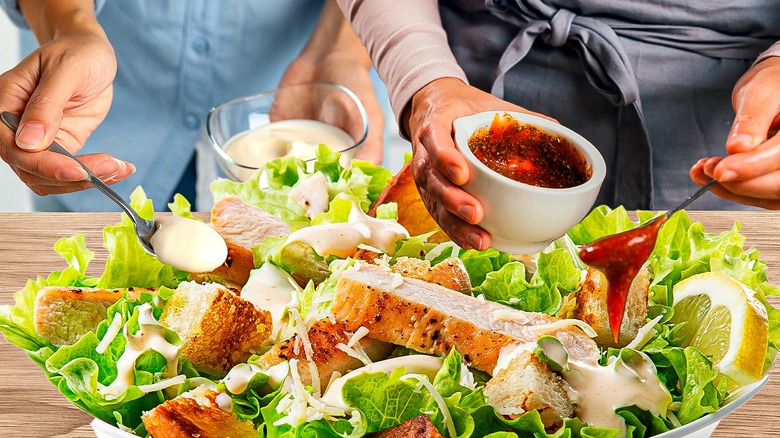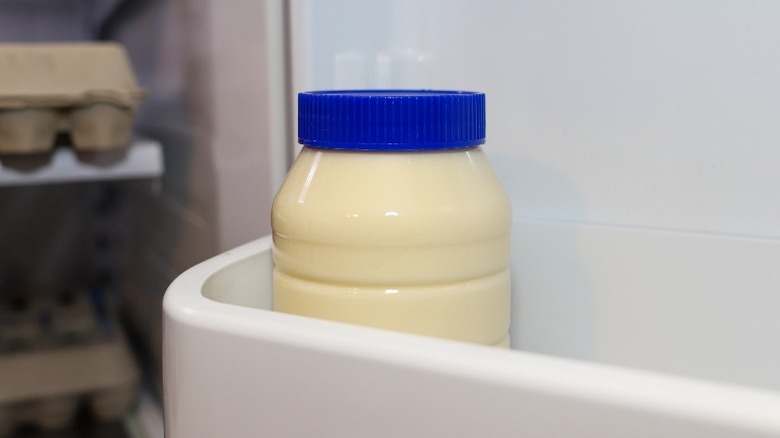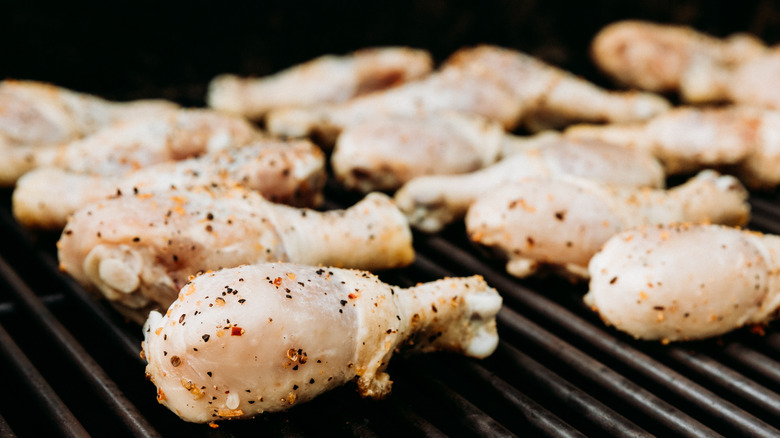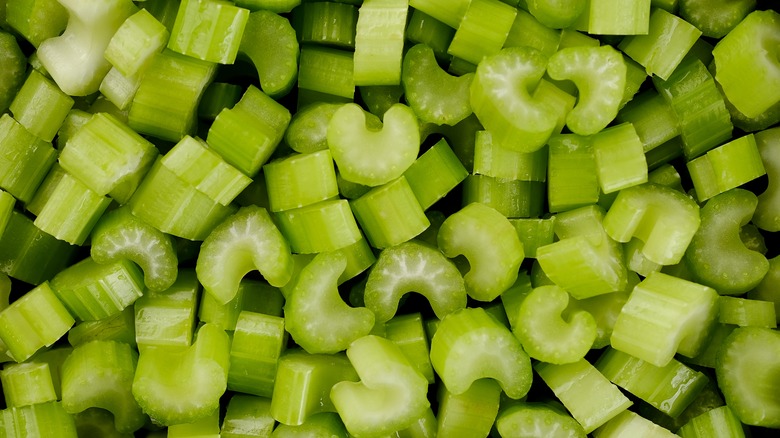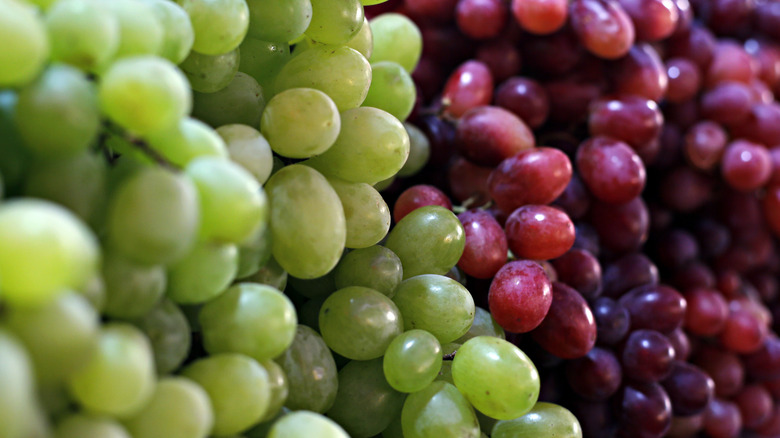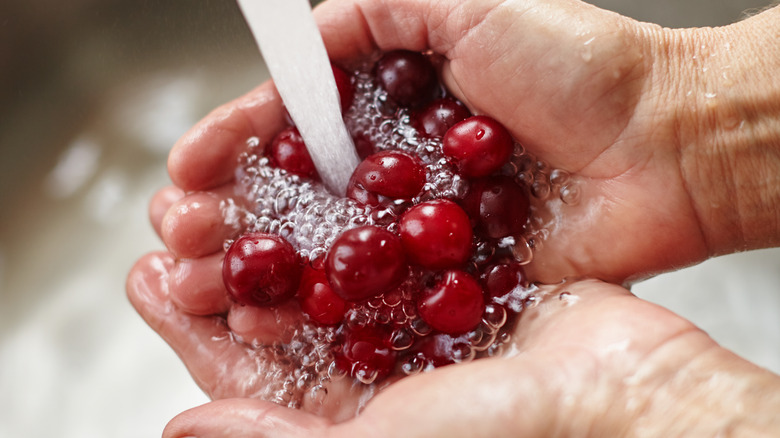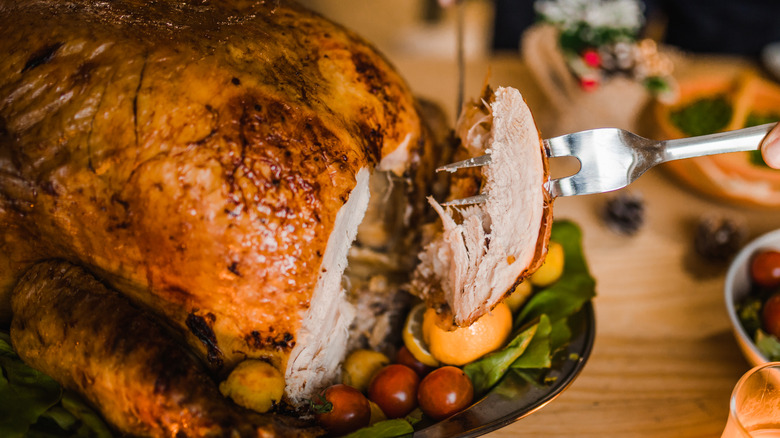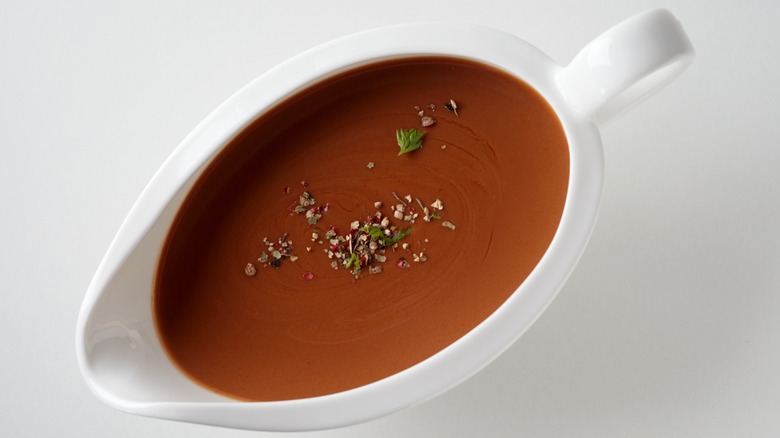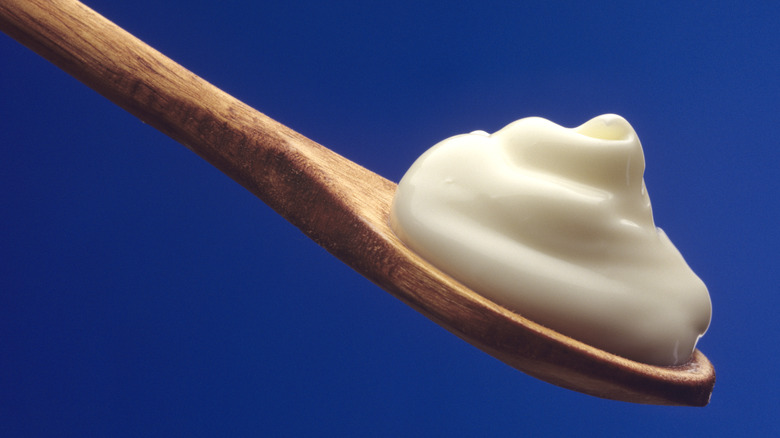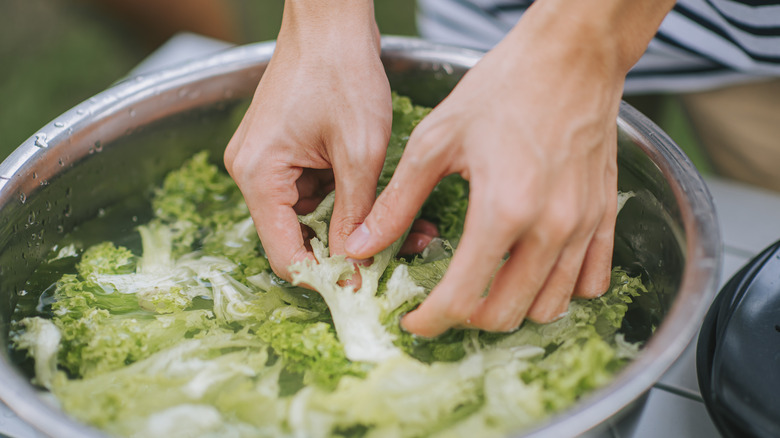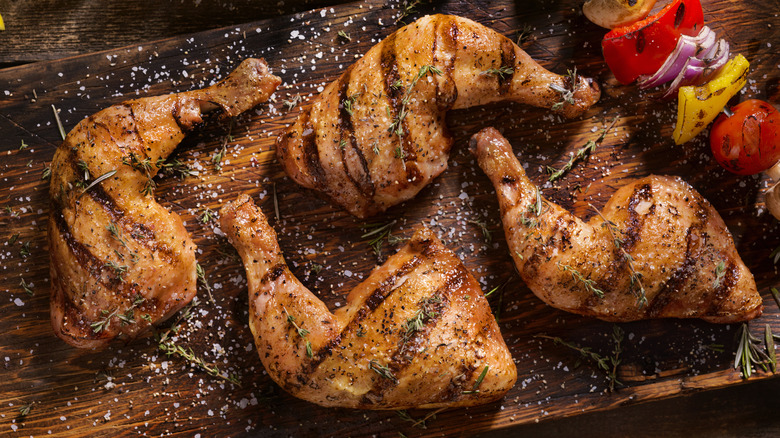11 Ingredients You Need To Avoid Putting In Chicken Salad
Chicken salad has long had a reputation for going bad in hot weather. When you examine the history of this dish, this makes sense. Back in the 1800s, before refrigeration was particularly widespread, people made different types of mayonnaise-based salads as a way to avoid food waste. The idea was to take leftover bits of chicken, ham, or fish, mash them up with some mayonnaise, and serve it the next day on lettuce or bread. The resulting salads could be anything from white fish salad to salmon salad to classic chicken salad.
Unfortunately, however, this dish was not always the safest to eat — especially considering the questionable food preservation tactics that cooks used 200 years ago. Around this time, people would prepare their chicken salad using meat that had literally been sitting out all night. Often, the role of mayonnaise in these recipes was to make the leftover meat taste more palatable. We can imagine that this recipe did not always work out for the best, as food poisoning was more prevalent during this time.
Of course, the invention of the refrigerator changed everything, making it easier for home cooks to whip up safer versions of traditional chicken salad. That being said, this meal is still not completely risk-free. To make a more food-safe dish, these are the 11 ingredients to avoid adding to your chicken salad.
1. Spoiled mayonnaise
Spoiled mayonnaise is one of the main concerns of chicken salad. We can especially see that at picnics, where chicken salad is known as a somewhat controversial thing to serve — as mayonnaise that's been basking in the sun for a few hours doesn't seem like the safest thing to eat. Although you may be more worried about the chicken component going bad, there is reason to be a little concerned about the mayonnaise in your chicken salad.
According to the United States Department of Agriculture, there is a specific way mayonnaise should smell; it should mostly smell like oil, with hints of vinegar and spice. However, spoiled foods oftentimes take on a pungent or otherwise unpleasant smell, as well as an unpleasant flavor or texture. The USDA recommends that you should never cook with mayonnaise that smells even slightly off, in order to minimize your chances of food poisoning.
That being said, it is also important to remember that, while stinky mayonnaise is almost always spoiled, not all spoiled mayonnaise is stinky. For this reason, be sure to keep your eye on the expiration date of your product. The USDA warns that a jar of mayonnaise does last longer than two months after opening.
2. Undercooked chicken
Although mayonnaise can certainly cause food poisoning, it's not the only chicken salad ingredient that can lead to a bad result. Raw or undercooked chicken is also a common culprit of foodborne illnesses, according to the Centers for Disease Control and Prevention. Raw chicken can be full of harmful bacteria, including salmonella, campylobacter, and Clostridium perfringens. In other words, if you don't cook your chicken all the way through, your chicken salad can leave you with a nasty stomach ache.
While avoiding undercooked meat might sound like an easy task, it's more challenging than you might think. Many people still believe that once chicken meat has turned white, it's ready to serve. But unfortunately, that's not always the case. Oftentimes, chicken that appears to be done on a visual level actually contains pockets of undercooked meat. For this reason, the USDA recommends using a meat thermometer to judge whether or not your bird is fully done. As per the organization, no chicken is safe to eat unless it has been heated to 165 degrees — regardless of how the meat looks.
The best thing you can do when getting ready to make chicken salad is to follow the governmental guidelines for food safety. Make sure to insert your meat thermometer into the thickest part of the meat without touching the fat, gristle, or bone (via USDA).
3. Cross-contaminated ingredients
When it comes to guessing which food items cause food poisoning, celery might not be at the top of your list. After all, this fantastic chicken salad ingredient doesn't need to be cooked before consumption, meaning that you can just chop it up and throw it in with the rest of the recipe. However, while celery might be an easy element to add to a chicken salad, this vegetable is not as safe as it might seem.
The reality is that celery can get easily cross-contaminated. According to the CDC, people who do not adequately wash their hands after handling raw meat can easily transfer dangerous bacteria from their skin to other items in their kitchen. This means that home cooks who touch raw chicken and then proceed to handle other ingredients (like celery) can actually contaminate them. The best way to avoid this is by scrubbing your hands for at least 20 seconds with soap and water before touching your celery.
Poor hand washing is not the only way that home cooks can cross-contaminate their celery. Washing your chicken in the sink — and then using that same sink to rinse your celery sticks — can also cause the spread of bacteria. The organization warns against placing your bird in the sink under any circumstances.
4. Bruised grapes or cherries
There is nothing white like adding some tart fruit, like grapes or cherries, to your chicken salad. After all, the sweet yet sour flavors of these ingredients can add some complexity to an otherwise savory meal. That being said, you shouldn't just grab a random handful of grapes or cherries and toss them into your salad. Instead, the USDA advises examining each and every piece to ensure that they aren't bruised or otherwise damaged. As explained on the government website, the reason for this is that these injured parts of fruit can be a breeding ground for harmful bacteria. The best thing you can do is cut out these areas before adding cherries or grapes to your chicken salad.
Fascinatingly, this is not the only thing you can do to ensure that your ingredients are safe to eat. The USDA also recommends rinsing the dirt off of your grapes and cherries before adding them to your salad. This will prevent bacteria from lingering in the fruit and making its way into your meal.
Another safety measure that you can keep in mind is that pre-sliced fruits must always go straight into the refrigerator to avoid spoiling. If you are thinking of chopping up your grapes or cherries well before adding them to your chicken salad, you will want to remember this tip. Don't prepare your fruits and then leave them on the counter. Instead, store them in the fridge.
5. Fruit washed long before assembling your salad
These days, food preparation is a huge deal. Whether it be preparing your meals days in advance or prepping a recipe the night before, more and more people are getting behind this movement. While food preparation is overall a positive practice, not all recipes work well when prepared in advance. This is especially true when it comes to getting your cherries and grapes ready to throw into a chicken salad. After all, preparing these fruits in advance can actually increase your chance of contracting a foodborne illness.
According to the USDA, washing your grapes or cherries long before serving them will not prevent the spread of dangerous bacteria. On the contrary, doing so could actually encourage bacterial growth. For this reason, the government organ recommends rinsing your fruit right before you serve it. This means that you should not clean your cherries or grapes until immediately before adding them to your chicken salad.
Home cooks who plan on adding sliced fruit to their salads should take the extra precaution of rinsing the fruit right before slicing it. The reason for this is that bacteria often lingers on a fruit's outer skin. As a result, when you cut your cherries or grapes, you might push some of this bacteria into the flesh of the fruit. Ultimately, this would increase your odds of food poisoning.
6. Chicken leftovers that have been sitting out for too long
Imagine that you prepared a roast chicken for a picnic, but your guests only ate about half of the meat. You might want to be tempted to use the leftovers to make a scrumptious chicken salad. After all, the idea of putting leftovers to use can seem like a great way to combat food waste. Plus, repurposing scraps of chicken was one of the reasons that this mayonnaise-based salad grew popular in the U.S. in the first place.
Although this might seem like a great idea, it can actually be dangerous to consume chicken that has spent a long period of time outside of the refrigerator — even if it has been cooked. In fact, according to the USDA, temperatures between 40 and 140 degrees are ideal for bacterial growth. This means that a chicken that sits out in the sun at a picnic — or even on your counter after a meal — has a higher risk of containing harmful elements that could lead to foodborne illness.
If you do want to use last night's chicken in your mayonnaise-based salad, fear not. Just keep in mind that leftover chicken needs to go through a very specific storage process in order to be considered safe for consumption. The best thing you can do is properly store your chicken in the fridge immediately after serving. This will minimize the risk of contaminating your meat.
7. Expired gravy
While traditional chicken salad can taste fantastic, plenty of people like to elevate their recipe a bit. One way to do this is by adding a dollop of gravy to the mix. The reason that this ingredient works so well in chicken salad is that it already contains lots of fat, giving your recipe an extra boost of flavor. Of course, if you make your gravy using chicken giblets, this can work particularly well, as this ends up accentuating the flavor of the bird. The result is a chicken salad that is extra savory.
Unfortunately, adding gravy to chicken salad is not always so simple. As with many things in the kitchen, using this secret ingredient only works so long as you apply a couple of food safety rules. The main one is to keep in mind that, according to the USDA, gravy only keeps for about three to four days in the refrigerator. While you can use leftover gravy in your chicken salad recipe, you need to be careful not to wait too long before putting this element to use.
Naturally, the easiest way for you to minimize your risk of foodborne illness is to make a fresh batch of gravy to use in your chicken salad. You can also use frozen gravy in your recipe, although do remember that this element only keeps in the freezer for around two to three months.
8. Thawed mayonnaise
In order to keep your mayonnaise for a longer period of time, you might wonder if it's okay to store it in the freezer. After all, it can be nice to purchase ingredients in bulk and then freeze them for later. Unfortunately, as revealed by the USDA, this is not a great idea when it comes to mayonnaise. The freezing process interferes quite a bit with the quality of this ingredient. In practice, this means that adding thawed mayonnaise to your chicken salad could actually downgrade the taste of your creation.
There is a science that explains exactly why this happens. Freezing an ingredient causes ice crystals to form. When these crystals eventually melt during the thawing process, they break down milk-like substances like mayonnaise and cream. As a result, the individual ingredients inside your mayonnaise will tend to separate as it melts. This will often leave you with a curdled mess; one that's hardly ideal to use in a chicken salad.
9. Unwashed lettuce
Chicken salad can taste especially refreshing when served on a bed of fresh lettuce. However, before incorporating this crunchy veggie into your recipe, be sure to rinse it thoroughly. While this might sound like an easy step to skip, this is not a place where you necessarily want to cut corners. Historically speaking, unwashed lettuce has created a number of issues over the years. Even in 2023, the USDA issued a recall of chicken salads containing lettuce, due to a listeria outbreak. At the time, CNN reported that this particular foodborne illness can be especially dangerous for pregnant women, newborn babies, the elderly, and other people with compromised immune systems.
Luckily, there is an easy way to keep your lettuce bacteria-free. According to the USDA, you should start by dividing your lettuce into individual pieces so that you can rinse them in cold water one by one. As you inspect each of the greens, be sure to throw out those that are bruised or damaged. This will prevent bacteria-rich areas from contaminating the remainder of your salad. Additionally, you should be sure to dunk your greens in a mixture of vinegar and water for several minutes in order to kill any bacteria that still might be lingering on the surface of your greens.
10. Overcooked or dry chicken
Food safety is incredibly important, but it's not the only factor that can determine which ingredients to use and which ones to avoid in your chicken salad. Flavor and texture also matter a lot. To ensure that your chicken salad tastes the way that it should, you should avoid using overcooked or dry chicken in your recipe.
Unfortunately, as we cook chicken, the moisture of the bird slowly evaporates. This means that the longer that the meat is exposed to high temperatures, the dryer your chicken will become. As revealed by the USDA, chicken is only safe to consume once it has reached an internal temperature of 165 degrees. You shouldn't serve a chicken that has been heated much higher than this. If this happens, your chicken can get rubbery, stale, or dry. Thus, you could end up with a chicken salad that has a tough or chewy texture.
While this scenario is certainly less than ideal, there is a way to avoid this. Rather than trying to estimate the internal temperature of your bird, try purchasing a meat thermometer that will help you monitor its progress. Keep in mind that the temperature of your chicken will continue to rise even once you remove it from the heat.
11. Dark meat
Traditionally, both white meat and dark meat go into a chicken salad. But these days, more and more people are making their chicken salad without dark meat and instead choosing to rely exclusively on white meat for their recipes. While this may seem like an odd choice at first, there is a reason behind this change.
Ultimately, dark meat contains far more flavor than white meat. Due to a higher concentration of the protein myoglobin, chicken thighs and drumsticks tend to be far richer and meatier than white meat cuts of chicken, such as chicken breast. While this may be a good thing at a barbecue, it might not be so great for chicken salad.
After all, this meal often contains several different elements, ranging from grapes and cherries to celery to mayonnaise. With all of these different flavors mixing together, it is important that no one ingredient outshine the rest. For this reason, many home cooks like to rely on white meat as a neutral backdrop to an otherwise flavor-filled meal.
